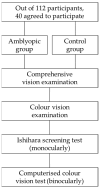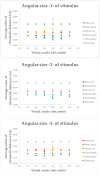Colour Vision Deficits in Children with Amblyopia: Impact of Angular Size of Stimuli on Detection
- PMID: 39846619
- PMCID: PMC11755483
- DOI: 10.3390/vision9010003
Colour Vision Deficits in Children with Amblyopia: Impact of Angular Size of Stimuli on Detection
Abstract
This study investigates colour vision deficits in children with amblyopia by employing a computerized colour vision test with varying stimulus sizes (1°, 2°, and 3°). The aim is to delineate the impact of amblyopia on colour discrimination in children and to determine the effectiveness of the computerized colour vision test in detecting these deficits. The study involved 40 participants, divided into 20 children with amblyopia and 20 without amblyopia (control group). Our findings reveal that, during binocular viewing, children with amblyopia exhibit significant impairments in colour vision both for red-green and blue-yellow axes, primarily for 1° chromatic stimuli, but not for larger stimuli (2° and 3°). These findings offer valuable insight into the functional visual limitations in pediatric amblyopia, potentially guiding more targeted clinical assessments and interventions.
Keywords: amblyopia; children; colour vision; computerized colour vision test; stimulus size; visual deficits.
Conflict of interest statement
The authors declare no conflicts of interest.
Figures










References
LinkOut - more resources
Full Text Sources

